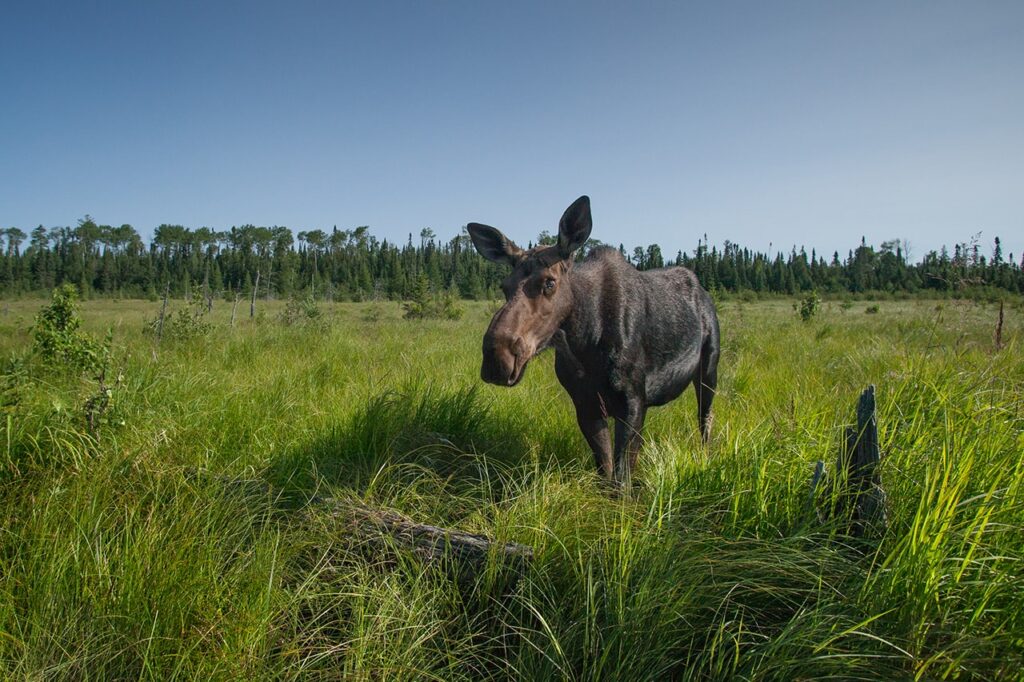
The moose of northern Minnesota, North Dakota, and Isle Royale do not warrant listing under the Endangered Species Act, the U.S. Fish and Wildlife Service (USFWS) recently announced. The agency was responding to a petition filed in 2016 to consider the region’s population for designation.
In the decision, the USFWS made two primary findings: the region’s moose population is stable, and is not distinct from other moose in the Rockies, Alaska, or the Northeast, and Canada just to the north.
“We considered differences in antler size and reproductive behavior, as well as control of moose harvest, management of moose habitat, and the moose’s conservation status within the range of the northwestern moose in the United States and Canada,” the USFWS wrote in its finding. “We do not have information that shows a difference, based on physical, physiological, ecological, or behavioral factors, between the populations in the United States and Canada.”
While moose in the southwest Great Lakes region have seen a decline in numbers in recent years, on the other side of the border, Ontario boasts 90,000 of the massive animals. It has seen some declines, but is still home to a healthy population.
Moose are built for cold weather and wild places, and northern Midwest is considered the southern fringe of the species’ range. Their decline in the region can be seen as the edge of suitable habitat shifting north as the climate warms.
The USFWS was urged to examine the region’s moose in 2015 by Honor the Earth and the Center for Biological Diversity. The two nonprofit groups pointed out that the region’s moose population has decreased drastically in recent years, and there are several known causes.

Four decades of shrinking moose range
The moose population in northeastern Minnesota has declined by about half in the past 15 years, while a separate herd in northwest Minnesota is all but gone — declining from 4,000 to less than 100. On the other hand, Isle Royale is essentially ecologically overpopulated with moose, part of the motivation for restoring wolves to bring back balance.
North Dakota has seen an increasing population on the far side of the state, but near the Minnesota border, it has also decreased drastically. The herd has been harmed by one of the same reasons blamed for Minnesota’s moose decline: brainworms spread by increasing whitetail deer numbers.
All the challenges facing moose survival are exacerbated by climate change. Winter in northern Minnesota is one of the fastest-warming seasons anywhere in the world, and summers are also offering more weather above the threshold for when moose start experiencing heat stress.
“They’re facing threats of climate change, habitat destruction, and disease, and we know that the Endangered Species Act is the best way to ensure that animals can get back on the path to recovery,” Collette Adkins, a Minneapolis-based attorney with the Center for Biological Diversity, told MPR News.
The petition to list the species noted that climate change is truly woven through the species’ challenges. Managing forests for good moose habitat is tricky in the first place, needing to maintain both young and old stands of timber. That is only more complicated in a changing climate.
Honor the Earth and the Center for Biological Diversity argue that the USFWS must take a long view of threats to the moose population. Climate change’s impacts have already been documented, and the most confident and mainstream science offers a rigorous range of possibilities for the climate and the Earth stretching for the next 80 years. All likely scenarios are bad news for moose in the Midwest.
Adkins told MPR News that the Center for Biological Diversity would review the denial and consider a lawsuit to press for protection.
More information:
- U.S. Population of Northwestern Moose Does Not Warrant Listing Under the Endangered Species Act – U.S. Fish and Wildlife Service
- Feds reject petition to place moose on endangered species list – MPR News
- Saving the Midwestern Moose – Center for Biological Diversity
- Petition to list the U.S. population of Northwestern Moose Under the Endangered Species Act (PDF) – Center for Biological Diversity, Honor the Earth

